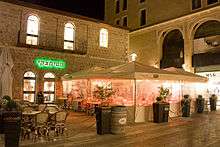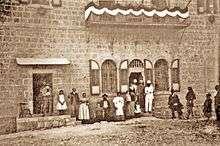Stern House
The Stern House, (Hebrew: בית שטרן) is a preserved and reconstructed building in Jerusalem, Israel. The house was built under Ottoman rule in 1877 in the early neighborhood of Mamilla, outside Jerusalem's Old City west from the Jaffa Gate and was rescued during a major reconstruction of the neighborhood in the late 20th and early 21st century.[1]

It is notable for the fact that in 1898, it served as the staying place of Theodore Herzl; also known as "The Visionary of the Jewish State" (Hebrew: חוזה המדינה).[1] The house currently serves as the Jerusalem "flagship store" of the Steimatzky bookstore chain and includes an outdoor cafe, as well as a small museum.[1]
History

The Stern House was built in 1877 for the Yehuda Stern family, recently emigrated from Germany. The Jerusalem quarters between the Old City walls were too crowded for the wealthy industrialist and his family, and with the new wave of people leaving the Old City and building new neighbourhoods outside its walls, Yehuda Stern purchased a plot of land from the Greek Orthodox Church in the then-new urban expansion area west of the Old City, on which he built a large European-standard house. Several generations of the Stern family lived in the building throughout its years of existence.[2][3]
Herzl visit; Herzl museum
In November 1898 the German Emperor Wilhelm II arrived in town to make an historic visit.[4] At the time, the Emperor was interested in the strengthening of the German influence in Jerusalem and the Emperor became involved in a number of, mostly religious affiliated, construction projects in the city. Theodore Herzl arrived to Jerusalem at the same time planning to meet with Kaiser Wilhelm and solicit his help in securing a Jewish homeland.[1][4] Stern quickly discovered that the room Herzl had booked at a hotel was taken by the Emperor's entourage. Michael Stern, the son of Yehuda, received it upon himself to host the Zionist leader at his home, which became Herzl's base of operation for his stay in the city.[5] Herzl remained at the house for 4 nights.[4]
At the time of Herzl's visit, the house was located at 18 Mamilla Street, next to the Jaffa Gate in the wall of the Old City.[4]
Later on the Stern family turned the room in which Herzl visited into a small museum, documenting his visit to the city. The "Herzl Room" museum in the house was open throughout the lives of the historic Mamilla neighborhood and was operated, for some years, by Yehuda Stern's great-grandchildren.[3]
Development and preservation
In the 1970s, there was a decision to develop the quarter and reconstruct in accordance to the plans of the architect Moshe Safdie.[5][3]
The house became the focus of controversy during the major reconstruction efforts as the original plans were such that almost nothing of the original quarter was meant for preservation. This called for the demolition of a number of Ottoman and Mandate-era buildings, including the Stern House. The demolition plans provoked an outcry and agreement to preserve the Stern House and several other significant buildings. While the house was set to be incorporated among the new buildings, the controversy did not end.[5][3][6]
Historic preservationists demanded that the building be preserved on its original site, and objected to a plan that entailed disassembling the building and reconstructing it on a nearby site. The legal challenge reached the High Court and, in the end, courthouse, however, decided that a full restoration could be done even after deconstruction. The building was then disassembled and its stones were marked, numbered and moved to a storage place nearby the construction project.[1][5][3]
The Mamilla project had further legal complications and feuds which took numerous years, causing delays in construction. Only in 2006, with the end of the prolonged litigation and a reach of a financial settlement, were the works resumed in the frozen section of the project. Following this, the Stern House was, finally, put back together after being stored for a decade.[5][3]
Architectural historian David Kroyanker finds the reconstructed building and the new neighborhood in which it is set, "close to perfection: it's aesthetic, it works - people come here in large numbers. It's alive and it is a very successful combination of old and new, of restoring this place to its former function - an economic center with leisure and entertainment."[5]
Bookstore and Museum
The building now houses the Jerusalem "flagship store" of the Steimatzky bookstore chain and an outdoor cafe.[7][8]
The lower level of the building houses a small, free museum focusing on the history of the bookstore chain and on Herzl's visit to Jerusalem. On display are photographs of Herzl in Jerusalem, Israeli bank notes featuring portraits of Herzl, and the hat that he wore on his visit to Jerusalem. The museum also depicts the history of the Steimatzky chain, including photographs of the long vanished Steimatzky branch in Beirut, Lebanon[8] The store's branches in Beirut, Baghdad, Cairo and Damascus were all nationalized after the establishment of the State ofIsrael in 1948.[9]
References
- A guide to buildings in Jerusalem Archived 2012-02-24 at the Wayback Machine, Aviva Bar-Am, Jerusalem Post
- Herzl Slept There, Felice Maranz, The Jerusalem Report, Apr 4, 1991.
- High Court Order Delays Stern House Demolition, Jerusalem Post, Norm Guthartz, May 4, 1990.
- The imaginary voyage: with Theodor Herzl in Israel, Shimon Peres, Arcade Publishing, 1999, p. 57.
- From prosperity to decay and back again, Jerusalem Post, Aug. 27, 2009, Peggy Cidor
- Article: Herzl's old home to be moved, Bill Hutman, Jerusalem Post, Aug. 22, 1996.
- Jerusalem Journal, June 7, 2007, History and trends blend in Jerusalem as deluxe mixed-use center opens in historic area, Orit Arfa
- Grapevine: Steimatzky on display, Jun. 12, 2008, Greer Fay Cashman , THE JERUSALEM POST
- Buy the book, Ron Friedman, Jerusalem Post, July 11, 2009
| Wikimedia Commons has media related to Stern house. |